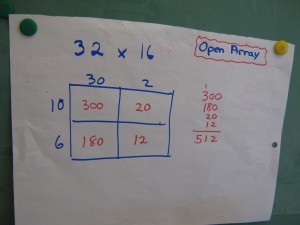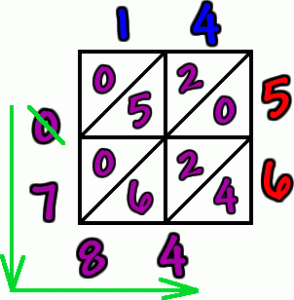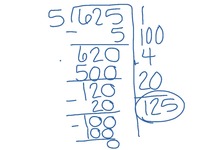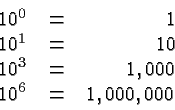Math Basics
Here are the main things in math:
Addition- When you add, you combine 2 numbers to produce a total. In the problem 2+10=12, 2 and 10 are your addends and 12 is your sum.
Subtraction- When you subtract, you take one number away from another to get a smaller number. In the problem 15-10=5, you take 10 away from 15 to get your difference of 5. When you have a problem like 20-15=5, you make 20 be 1 ten and 10 ones because 1 ten+10 ones=20. Then you subtract 5 from 10 and 1 from 1 to get 5.
Multiplication- When you multiply, you add one number however many times the other one tells you to. In the problem 3 x 4, 3 can be added to itself 4 times because multiplication is repeated addition. So, 3 x 4 is equal to 3+3+3+3. In all, the product of 3 x 4 is 12, because 3+3+3+3=12.
Ways to multiply- There are two simple ways to multiply. The first way is to use the open array. When you use the open array, you split the digits apart from each other and multiply separately. When you have all of the separate products, add your products all up to get your answer. In the problem 32 x 16, you make 32 into 30 and 2 and you make 16 into 10 and 6 then you multiply separately. 30 x 10=300, 2 x 10=20, 30 x 6=180, and 2 x 6=12. Then add 300+20+180+12 to get 512 as your total. A picture of this problem is shown below.
The other way is to use the lattuce. The lattuce is a little bit more tricky, and might need a little bit more practice to master. When you multiply with the lattuce, you add the numbers in each diagonal column up to get a product. The problem 14 x 56 is solved below using the lattuce.
Division- When you divide, you make groups depending on the other number. In the problem 8 divided by 4, 8 has 2 groups of 4 because 2 x 4=8. If you have numbers you can’t divide, that’s called the remainder. In the decimal category, you’ll learn how to divide the remainder.
Ways to divide- One way to divide is to use the Big 7. When you use the Big 7, you put the number you are multiplying the divisor by alongside the longest part of the 7 and once you’ve divided the number down all the way, you add all of the numbers up to get your answer. The problem 625 divided by 5 is shown below.
Another way to divide is to use the regular algorithm. The algorithm is basically the Big 7 but without the long line on the side and the answer goes on top of the top line. To divide, use the DMSB Method. First, Divide the dividend by the divisor, then Multiply the divisor by another number. When you get the product, Subtract the product from the dividend, then, if you can’t divide, Bring a zero/number down.
Divisibility Rules- Here are the rules for being able to divide a number.
2- If a number is divisible by 2, it ends in an even number. (2, 4, 6, 8, and 0)
3- If the sum of the digits is a multiple of 3. (Ex: 63, 6+3=9 and 3 x 3=9, so 63 is divisible by 3.)
4-If the last 2 digits are divisible by 4, then the whole number is divisible by 4. (Ex: 428, 28 divided by 4=7, so 428 is divisible by 4.)
5- If the number ends in a 5 or a 0, it’s divisible by 5. (Ex: 10, 10 is divisible by 5 because it ends in a zero.)
6- If a number is even and is divisible by 3, it’s also divisible by 6. (Ex: 12, 12 is divisible by 6 because it’s even and is divisible by 3.)
7- Divide the number.
8- Divide the number.
9- If the sum of the digits is 9, then the number is divisible by 9. (Ex: 441, 4+4+1=9, so 441 is divisible by 9.)
10- If the number ends in a 0, it’s divisible by 10. (Ex: 120,is divisible by 10 because it ends in a 0.)
Math proprieties-
Communitive Property- Add/multiply in any order. Ex: 10+2=2+10.
Associative Property- The ability to have the same numbers in the same order but in different groupings. Ex: (7+2)+3 = 7+(2+3).
Distributive property- The act of splitting numbers apart for easier multiplying. Ex: (4 x 10)+(4 x 9) or (4 x 20)-(4 x 1).
Identity Property of One- Any number times 1 is itself. Ex: 10 x 1=10.
Zero Property of Addition- Any number plus zero is itself. Ex: 4+0=4.
Counting Principal- How many combinations can you make? (PGBR, pairs: PG, PB, PR, GB, GR, BR: 6 pairs.)
Factors- A factor is a number that is multiplied with another to get another number.
Prime– If a number only has one factor other than itself, it’s prime.
Composite– If a number’s composite it has more than only one other factor.
Note: 1 and 0 are neither!
Place Value- In place value, you identify where a number is in a bigger number. In the number 7,689,321 ,1 is in the ones, 2 is in the tens, 3 is in the hundreds, 9 is in the thousands, 8 is in the ten-thousands, 6 is in the hundred-thousands, and 7 is in the millions.
Rounding- When you round, you estimate or make a number easier to multiply or divide. If the number is a 1, 2, 3, or 4, you round down. If the number is a 5, 6, 7, 8, or 9,you round up. In the number 678, you would round up to 680, because the number behind the 7 is an 8.
Number Forms-
Standard Form- The number in just regular numbers. (Ex: 7,892)
Expanded Form- When you split the number apart. (Ex: 7,000+800+90+2=7,892)
Word Form- When you put the number in words. (Ex: Seven thousand, eight hundred ninety-two)
Number Word- Using just numbers and words. (Ex: 7 thousand, 8 hundred 92)
Exponents– Exponents are the tiny number right by a number. When you have a exponent, you multiply the number however many times the exponent tells you to. In the example 10 with an exponent of 3, 10 to the power of 3 would be equal to 10 x 10 x 10. Examples are shown below.
To get practice on math skills, try going to IXL Math



